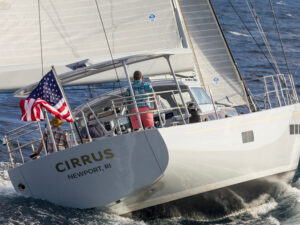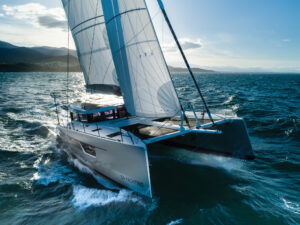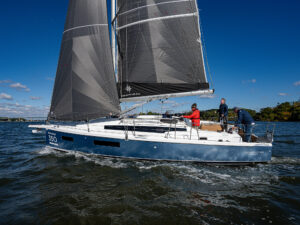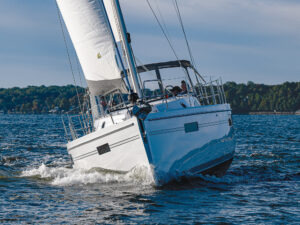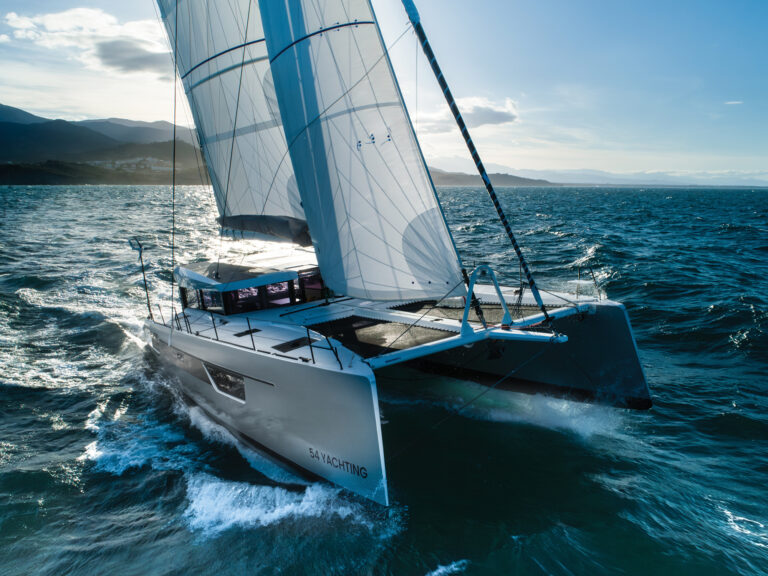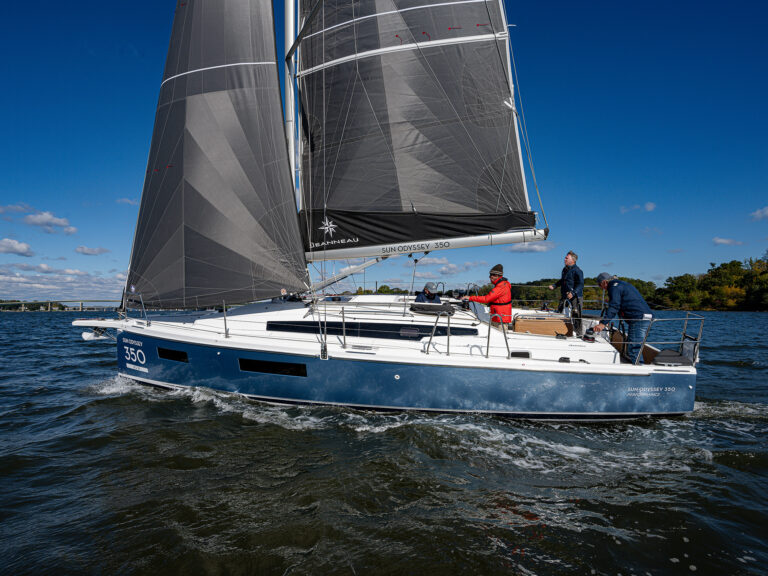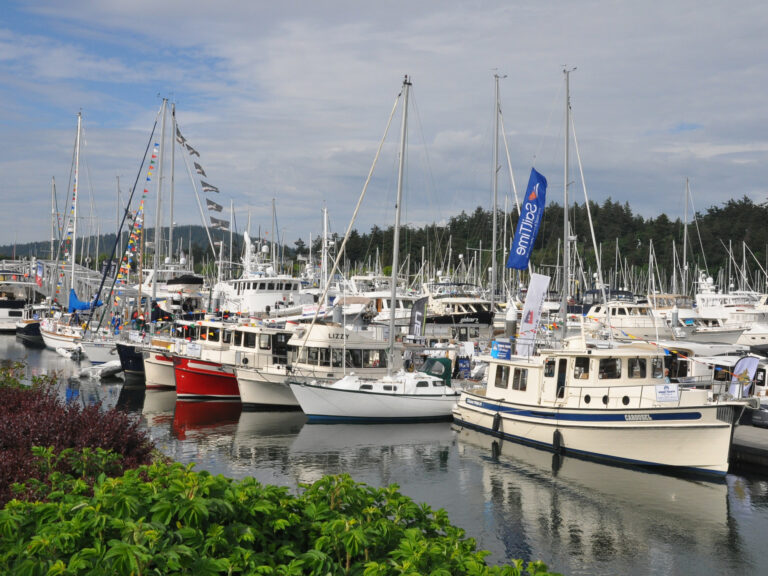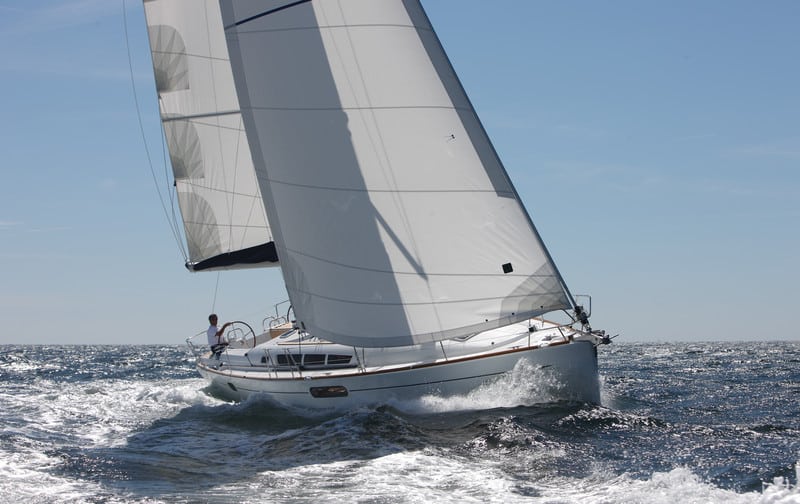
Ever since Jeanneau became part of Groupe Beneteau, the company has maintained its separate identity, which is reflected in its boats’ styling, both interior and exterior, and in the methods used in their construction. Having competing brands under one roof can generate healthy internal competition, with the benefit that any advance in construction techniques or engineering pioneered by one company can be quickly adapted by others under the same corporate umbrella.
If, by the same process, cross pollinating between brands risks diminishing their distinctions, it’s not evident in the Sun Odyssey 44i, which clearly asserts the Jeanneau style of being softer around the edges, both outside and inside.
Let’s look first belowdecks, where the similarities between the current Beneteau and Jeanneau interiors-linear cabinetry in Alpi wood-composite-finished panels-end with color and edge detail. Jeanneau uses the much paler “Fine Teak” finish and trims the cabinets with a rounded molding, reminiscent of earlier Jeanneaus.
Where the 44i’s interior is fully contemporary is in the generous allotment of space to sleeping cabins. It’s particularly noticeable forward in the three-cabin layouts (of which there are two variants): The entire boat forward of the mast is devoted to the master suite. In this arrangement, the centerpiece is an island berth that’s queen-sized in the hip region and flanked by a dressing seat, hanging locker, and, of course, en-suite head and shower. Additional stowage for personal items is provided in lockers above and outboard of the berth.
Aft, the ample width of the hull is divided equally between two more cabins, and here the builder offers a choice between a layout that has mirror-image heads for each cabin and one that has a single head to port, and a good-sized nav station to starboard, as in the boat we tested. (The available four-cabin version combines a similarly democratic division of sleeping space forward together with the two-heads-aft arrangement.)
In all arrangements, the U-shaped settee occupies the starboard side and, together with a centerline seat, will comfortably accommodate six people. The galley occupies the entire port side, which results in a large work space for the chef.
The even grain pattern of the Alpi veneer, together with white accents along the hull, enhances the openness of this central living area, and the whole saloon is well lit by overhead hatches and Jeanneau’s trademark portlights in the cabin-trunk sides and in the hull. The nav desk is recessed into a larger flat surface that opens to reveal a bottle locker. This surface has no fiddles but blends with the overall soft-edged, linear decor. The absence of a partial bulkhead by the nav desk, once favored as a styling as well as structural feature, could present a puzzle when deciding on where to add electronic accessories.
On deck, the soft-edge styling theme continues, especially around the cabin top, where the radiused corners reduce the visual impact of the coachroof’s height.
For a boat of this size, the side decks aren’t particularly wide, but the important walkway alongside the cabin trunk is well defined and clear of toe stubbers. To gain access to the mast, the best step up is by the shrouds, and it would be more secure if the nonskid extended around the radius of the coachroof edge.
Some thought has gone into the anchoring system. A short but substantial stainless-steel fabrication projects two side-by-side anchor rollers forward of the stemhead, where they keep sharp-pointed anchors away from the hull gelcoat. The starboard roller leads to the windlass, which is mounted on centerline and recessed into the deck. A bubble in the anchor-locker hatch lid allows the chain to be hauled with the lid closed, which is just as well because the lid, when open, leaves precious little standing room on the bow.
In the cockpit, soft contours make for comfortable seating under way and also when at rest, when the cockpit table, generously furnished with cupholders, opens up to create an outdoor lounge. The table is mounted on a high plinth molded into the cockpit sole, which lends it considerable rigidity while allowing opening ports to be fitted above the aft berths.
As is de rigueur today, the 44i has twin helms. Behind them, both the cockpit sole and seat are radiused to give the helmsman purchase when sailing. The seats open to reveal deep cockpit lockers, and additional stowage is provided in a shallow locker under the port cockpit bench.
Under way, the Sun Odyssey 44i met expectations as far as we could test them on a day of mostly light air. We were able to maneuver comfortably around the fleet assembled for the start of the Chesapeake Bay Schooner Race, and when for a brief while the wind piped up to 10 knots, we were able to get up to 6 knots while sailing closehauled. In these conditions, the boat heeled little, responded promptly to the helm, and generally handled well, aside from the need to negotiate the length of the cockpit to reach the mainsheet and traveler controls.
For auxiliary power, the test boat had a 75-horsepower Yanmar diesel driving a conventionally shafted propeller, a combination that pushed it effortlessly up to hull speed. The boat maneuvered quite well, stopping from full ahead in little over a boat length and, with the helm hard over, turning in its own length at 1,500 rpm. At the higher engine revolutions, the noise was noticeable belowdecks, and the prop wash created considerable torque on the helm.
Overall, the Jeanneau Sun Odyssey 44i demonstrates that this is about the optimum size for a cruising sailboat: You can cut up the interior to accommodate up to six crew in relative luxury, the sailhandling isn’t daunting without power winches (although the test boat did have them), the hull has long enough legs to give it a good range within a day’s sail (and the 63 gallons of fuel, prudently burned, should deliver perhaps 400 miles), and the boat is big enough not to feel small in a blow.
Jeremy McGeary is a longtime CW boat reviewer and contributing editor.
Specs
LOA 45′ 1″ (13.74 m.)
LWL 37′ 6″ (11.43 m.)
Beam 14′ 4″ (4.37 m.)
Draft (stnd./perf./ 6′ 8″/7′ 6″/5′ 4″
as sailed) (2.03/2.32/1.62 m.)
Sail Area (100%) 848 sq.ft. (70.69 sq. m.)
Displacement 21,892 lb. (9,930 kg.)
Ballast (stnd./perf./ 6,512/6,283/6,967 lb.
as sailed) (2,954/2,850/3,160 kg.)
SA/D 17.3
D/L 185
B/D (stnd./perf./ .30/.29/.32
as sailed)
Water 163 gal. (617 l.)
Fuel 63 gal. (238 l.)
Engine 75-hp. Yanmar
Designer Philippe Briand
Price $259,000
Jeanneau America
(410) 280-9400
www.jeanneau.com

